Oral History with Mohammad Amini: Sacred Landscapes and Moharram Rituals in Varamin
Featuring Mohammad Amini, interviewed by Jabbar Rahmani and Maryam Rafeienezhad
Mohammad Amini, a respected local historian from Varamin, was born on April 23, 1952. He earned his Bachelor’s degree in Social Sciences from the University of Tehran and later completed his Master’s in Sociology at Tehran Azad University’s Central branch. Under the supervision of anthropologist Dr. Javad Safinejad, Mr. Amini wrote his undergraduate thesis in 1979. Encouraged by his mentor, he developed a deep passion for studying his hometown of Varamin.
Since then, Mr. Amini has conducted extensive field and historical research, authoring nine books and publishing over 100 articles in prestigious academic journals. His work primarily focuses on exploring Varamin’s rich history, diverse tribes, and vital water resources. For many years, Mr. Amini shared his knowledge and enthusiasm with younger generations as a teacher in Varamin’s schools. Today, he continues to be an influential figure in preserving and promoting the rich cultural heritage of Varamin.
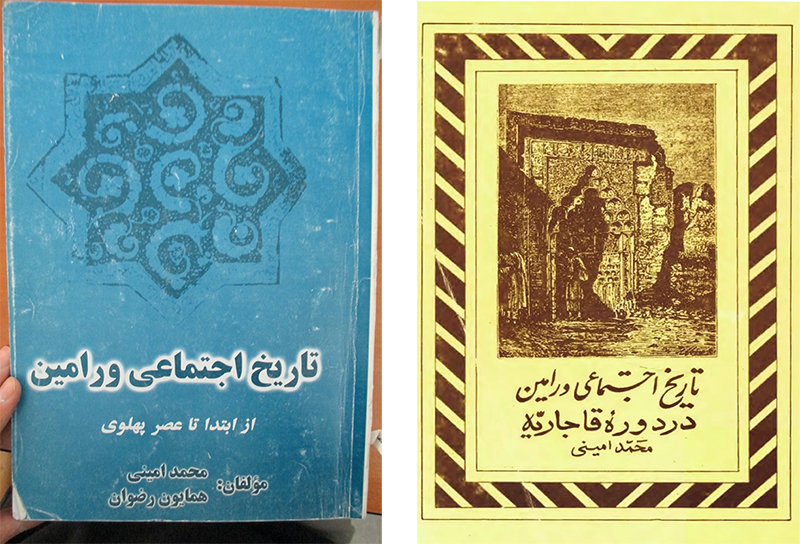
تاریخ اجتماعی ورامین از ابتدا تا عصر پهلوی and تاریخ اجتماعی ورامین در دورۀ قاجاریه
Notice the luster star tile on the left and the print from Jane Dieulafoy’s La Perse (1887) on the right. The latter is the mihrab in the Emamzadeh Shah Hosayn in Varamin.
In January and May 2024, anthropologists Dr. Jabbar Rahmani and Ms. Maryam Rafeienezhad conducted an extensive oral history interview with Mr. Amini, spanning over five hours. This film presents a segment of those interviews and focuses on the rich history of Moharram mourning rituals in Varamin. Through vivid recollections of his childhood in the 1960s and diverse accounts of ceremonies held in the Kohneh Gel neighborhood and Emamzadeh Yahya, Mr. Amini offers viewers a unique glimpse into the past, bringing to life the spiritual and communal aspects of Varamin’s observance of Moharram.
The Film
Sites and Geography
Throughout this interview, Mr. Amini references many of Varamin’s sacred sites and landscapes, taking us on a broad tour of the city. The list below divides the sites by their locations in Kohneh Gel (the neighborhood home to the Emamzadeh Yahya), Varamin broadly, and beyond. Each site is linked in Google maps and variant names are provided.
This site list is distinguished by its combination of what we usually term ‘architectural heritage’ or ‘historical sites’ (Ilkhanid to Qajar periods), recent buildings constructed in Varamin (mosques, hosayniyehs), and sacred landscapes that resonate mostly in local memory (namely the qatlgah). This kind of mapping can only be accomplished by a local expert, and we are pleased to add it to our collection of maps.
Kohneh Gel (کهنهگل) neighborhood
- Emamzadeh Yahya, امامزاده یحیی: Ilkhanid, dated elements spanning 660/1262–707/1307; Safavid-period door dated 971/1563; extensive alterations to the overall complex and tomb in the late Qajar period
- Meydan-e Kohneh Gel, میدان کهنه گل, or qatlgah, قتلگاه: the site of Emamzadeh Yahya’s (d. 255–56/869–70) martyrdom
- Hosayniyeh Kohneh Gel, حسینیه کهنه گل: the hosayniyeh of the Kangarlu tribes, 1980s
- Masjed-e Bab ol-Havaʾej, مسجد باب الحوائج: the main mosque of Kohneh Gel
Varamin (ورامین)
- Masjed-e Emam Hasan, مسجد امام حسن (formerly مسجد پایین, Lower mosque)
- Masjed-e Abolfazl, مسجد ابوالفضل (formerly مسجد بالا, Upper mosque) (near where this interview took place)
- Emamzadeh Seyyed Fathollah, امامزاده سید فتح اللّه, inscription dated 889/1484 marking the completion of the building (see Architectural Heritage)
- Masjed-e Khatam ol-Anbia, مسجد خاتم الانبیا (formerly مسجد طاهری, Masjed-e Taheri)
- Masjed-e Saheb Zaman, مسجد صاحب الزمان (formerly مسجد واعظی, Masjed-e Vaʿezi)
- Congregational Mosque, مسجد جامع (masjed-e jameʿ ): Ilkhanid, elements dated 722/1322 and 726/1326; decorations completed in 845/1441; full restoration in the 1340s–70s Sh/1960s–90s
Beyond
- Emamzadeh Jaʿfar at Pishva, امامزاده جعفر, renovated/rebuilt during the reign of Shah Tahmasp I (r. 1524–76) and later restored and expanded during the reign of Fath ʿAli Shah Qajar (r. 1797–1834) (see Architectural Heritage)
- Emamzadeh Shahzadeh Mohammad at Ijdan, امامزاده شاهزاده محمد, renovated/rebuilt during the reign of Naser al-Din Shah Qajar (r. 1848–96)
Map 1. Sacred sites of Varamin, as narrated by Mohammad Amini. Sites are divided into three categories: emamzadehs (green), mosques (orange), and sacred landscapes (blue). Google Map created by Hossein Nakhaei, October 2024, with information supplied by Mohammad Amini and Jabbar Rahmani.
Ritual Objects and Memories
A main topic of discussion in this interview is the sacred ʿalam (علم) of the Kangarlu tribe, a standard in the form of a small cross mounted to the top of a tall pole. This ʿalam is currently missing, but thanks to documentary footage taken of Moharram processions (دسته, dasteh) near the Emamzadeh Yahya in Ordibehesht 1346 Sh/Moharram 1387/April 1967, we have clear evidence of its form and existence (fig. 2) (see also Vaziri, Tārīkh-e Varāmīn, p. 29–31; Amini and Rezvan, Tārīkh-e ejtemāʿī-ye Varāmīn, p. 129; and Bonyad-e Iran-shenasi, Shomārī az boqʿehā, p. 306). This footage also shows many other ritual objects, including ʿalamats (علامت, ceremonial standards) and parchams (پرچم, banners) depicting sacred shrines and Emam Hosayn’s white horse Zuljanah. Segments of this archival footage are interspersed throughout this film.
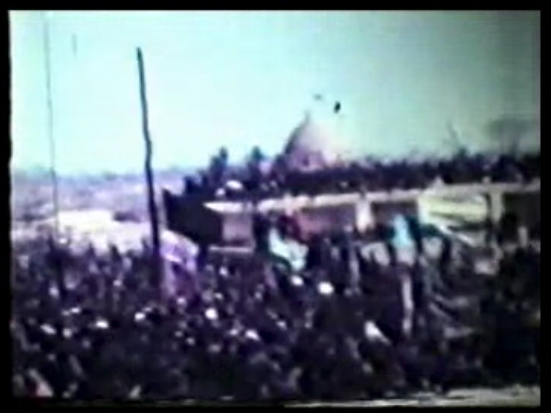
Key Terms
(images are screenshots from the 1967 film)
- dasteh ʿazadari, دسته عزاداری: mourning processions held during Moharram
- qameh zani (Ar. tatbir), قمه زنی: self-cutting with a sword
- zanjir zani, زنجیر زنی: chain beating, in reference to using chains to hit one’s back or shoulders
- sineh zani, سینه زنی: chest beating, in reference to pounding one’s chest
- ʿalamat, علامت: a ceremonial standard with multiple finials attached to a wide horizontal base
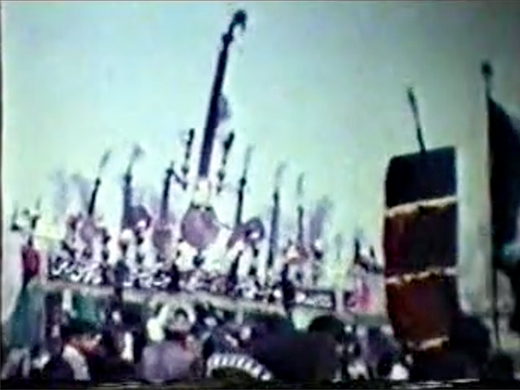
- ʿalam, علم: a ceremonial standard with a single finial (تیغه, tigheh) often paraded during Moharram processions (dasteh). Here, the reference is to the sacred ʿalam of the Kangarlu tribe, in the shape of a cross and mounted to the top of a tall pole.
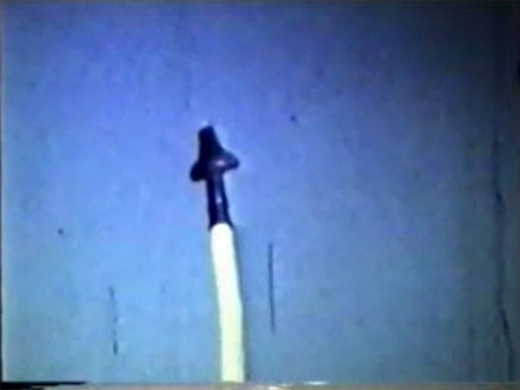
- parcham, پرچم: ceremonial textiles, banners, hangings, or flags that are paraded during dasteh or hung on the walls of hosayniyeh
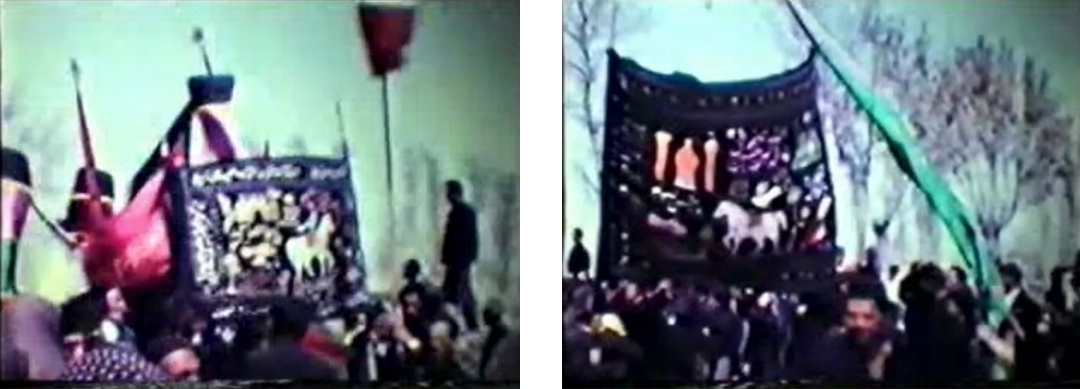
- maddah, مداح: religious eulogist
- mosalla, مصلی: large outdoor space for communal prayers
- nazr, نذر: a vow or the act of making a vow; nazri refers to votive offerings (ribbons, prayer beads, locks, food)
- heyʾat, هیئت: the religious and ritual community of a tribe and/or a neighborhood association
- hosayniyeh, حسینیه: a building used for religious ceremonies, especially during Moharram; typically with a large open hall for holding performances and gatherings
Books by Mohammad Amini:
- امینی، محمد. آب و آبیاری در ورامین. ورامین: واج، ۱۳۸۶ش. [Amini, Āb va ābyari dar Varāmīn, Water and Irrigation in Varamin] [Lib.ir]
- امینی، محمد. آموزش و پرورش در ورامین. ورامین: واج، ۱۳۸۹ش. [Amini, Āmūzesh va parvaresh dar Varāmīn, Education in Varamin] [Lib.ir]
- امینی، محمد. اقتصاد ورامین از مشروطه تا انقلاب اسلامی. تهران: کوشش پاینده، ۱۳۹۷ش. [Amini, Eghteṣād-e Varāmīn az mashrūṭeh tā enghelāb-e eslāmī, The Economy of Varamin from the Constitutional Revolution to the Islamic Revolution, 2018] [Nahang]
- امینی، محمد. اوضاع سياسي ورامين از مشروطه تا انقلاب اسلامي. تهران: رسول آفتاب، ۱۳۹۲ش. [Amini, Owzaʿe sīyasī-ye Varāmīn az mashrūṭeh ta enghelāb-e eslāmī, The Political Situation of Varamin from the Constitutional Revolution to the Islamic Revolution, 2013] [Lib.ir]
- امینی، محمد. تاریخ اجتماعی ورامین در دورۀ قاجاریه. [تهران]: شرکت افست، ۱۳۶۸ش. [Amini, Tārīkh-e ejtemāʿī-ye Varāmīn dar dowreh-ye Qajariyeh, The Social History of Varamin during the Qajar Period, 1989] [Ketabnak]
- امینی، محمد. عشایر منطقه ورامین در گذشته و حال. ورامین: واج، ۱۳۸۴ش. [Amini, ʿAshāyer-e manṭaqe-ye Varāmīn dar gozashteh va hāl, The Tribes of the Varamin Region: Past and Present, 2005] [Lib.ir]
- امینی، محمد و همایون رضوان. تاریخ اجتماعی ورامین از ابتدا تا عصر پهلوی. ورامین: انتشارات علمی فرهنگی صاحبالزمان، ۱۳۸۲ش. [Amini & Rezvan, Tārīkh-e ejtemāʿī-ye Varāmīn az ebtedā tā ʿaṣr-e Pahlavi, The Social History of Varamin from the Beginning to the Pahlavi Period, 2003] [Lib.ir]
Additional sources:
- وزیری، سعید. تاریخ ورامین. ورامین: [بینام]، ۱۳۵۸ش. [Vaziri, Tārīkh-e Varāmīn, The History of Varamin, 1979] [Lib.ir] [Shahr-e Ketab, new edition]
- بنیاد ایرانشناسی. شماری از بقعهها، مرقدها و مزارهای استان تهران و البرز. ج۲: شهرستانهای شهریار، فیروزکوه، کرج، نظرآباد و ورامین. طرح، بررسی و تدوین حسن حبیبی. تهران: بنیاد ایرانشناسی، ۱۳۸۹ش. [Bonyad-e Iran-shenasi, Shomārī az boqʿe-hā, marqad-hā, va mazār-hāye ostān-e Tehran va Alborz, A Selection of Shrines, Tombs, and Graves in the Provinces of Tehran and Alborz, 2010] [WorldCat] [Lib.ir]
Related pages:
- Filmed tour of Varamin
- Checklist catalog entries: Parcham, no. 48; ʿAlamat and Chelcheragh, no. 49
- Maryam Rafeienezhad’s essay on the present life of the Emamzadeh Yahya complex
Acknowledgements: We sincerely thank Mr. Amini for sharing his knowledge and participating in this film.
Our collaboration:
- Featured expert: Mohammad Amini
- Interviewers: Jabbar Rahmani, Maryam Rafeienezhad
- Video editor, subtitles: Hamid Abhari
- Editor, post-production: Keelan Overton
- Map: Hossein Nakhaei
- Translation: Hoda Nedaeifar
Citation (film): Mohammad Amini, “Oral History with Mohammad Amini: Sacred Landscapes and Moharram Rituals in Varamin.” Interviewed by Jabbar Rahmani and Maryam Rafeienezhad, edited by Hamid Abhari. Film in The Emamzadeh Yahya at Varamin: An Online Exhibition of an Iranian Shrine, directed and edited by Keelan Overton, 33 Arches Productions, January 15, 2025. Host: Khamseen: Islamic Art History Online.
Citation (this page): Keelan Overton, Jabbar Rahmani, Hamid Abhari, Hoda Nedaiefar, and Hossein Nakhaei, “Oral History with Mohammad Amini: Sacred Landscapes and Moharram Rituals in Varamin.” Film landing page in The Emamzadeh Yahya at Varamin: An Online Exhibition of an Iranian Shrine, directed and edited by Keelan Overton, 33 Arches Productions, January 15, 2025. Host: Khamseen: Islamic Art History Online.
